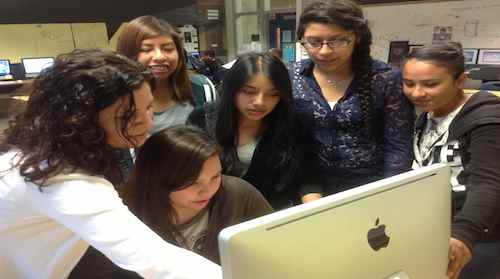Film Project on LA Street Vendors Brings Community Into the Classroom


Instructor Jacqueline La Torre (left) , students (left to right), Monica Rodas, Heidi Maqueos, Dahlia Perez, Magaly Ordonez and Tiffany Sosa.
 By Esmeralda Fabián, La Opinion/New America Media
By Esmeralda Fabián, La Opinion/New America Media
NAM Ed. Note: In 2011, California’s legislature passed AB 790, a statewide initiative aimed at addressing the growing number of high school graduates unprepared or under-prepared for either college or a career. Studies document that up to 70 percent of high school seniors fall into one of these two categories. The initiative targeted 20 school districts and nearly a third, or some 600,000 high school students across California. Schools implementing the Linked Learning Pilot Program – one of a number of school reform efforts in the state – integrate academic rigor with a demanding technical curriculum geared toward a professional field. In its first two years, the program has met with promising success. This is the second of three stories by New America Media’s ethnic media partners on how Linked Learning is being applied in some of the state’s most underserved communities.
LOS ANGELES – High school student Heidi Maqueos never thought much about the street vendors scattered about her neighborhood in East Los Angeles. That all changed, though, when she and several classmates produced a documentary about them as part of a class project.
The experience, she says, opened her eyes to the forces shaping her community.
“The problem of street vendors comes from having no immigration papers, [finding work in] the bad economy and being poor,” says Maqueos, a senior at the Los Angeles School of Global Studies.
The school is part of a statewide initiative known as the Linked Learning Pilot Program – established in 2011 under AB 790 and involving 63 districts and roughly 600,00 high school students across California. Advocates say Linked Learning programs not only address the needs of the state’s rapidly changing economy, but also help boost student performance.
“We had to research the pros and cons of doing business in the street, and the health, public health, law or potential economic impact of legalizing their businesses,” Maqueos explained.
She and four classmates produced the documentary, “A Forbidden Life: Plight of the Street Vendor,” for their Digital Media and Design class. Students in the class, says teacher Jacqueline La Torre, “learn technical skills in making visual media by getting involved in issues that affect their community and their environment.”
One of those skills, La Torre adds, is communication. Many of the students she works with initially struggle to engage with people outside their immediate circles, she says, noting that through the course of the program she has seen some “impressive strides.”
Reversing Trends
One-third of California high school students drop out before graduating, according to ConnectEd, one of several education reform groups that helped craft the pilot program. For those who do graduate, nearly one-third are unprepared for college or a career.
For California’s economy, those are disturbing figures. A 2012 report put out by the group California Competes notes that by 2025, the state’s workforce will suffer a shortage of about 2.3 million qualified workers who lack either a college or vocational degree.
Supporters of Linked Learning and similar models say their approach to education can help reverse these trends. Particularly for traditionally underserved populations, including African American and Latino students, the model has shown to be effective in boosting graduation rates.
Rosa Maria Hernandez is the Los Angeles Unified School District’s (LAUSD) Linked Learning program director. She says the benefits for students and the state are clear. “We know that today’s students need to be ready with the skills that employers are demanding,” she says, “whether they plan to go to college or choose a vocational career.”
Hernandez’ office oversees Linked Learning programs in 11 high schools across the district. Only two, Global Studies and Los Angeles High School of the Arts, are Linked Learning certified, meaning the entire curriculum is modeled on the Linked Learning approach. That approach consists of four key components: academic, technical, work-based – internships and work shadows – and finally a support structure that includes counseling and supplemental instruction.
“There are no requirements for students [or] schools that want to participate,” Hernandez says, apart from an administration that is “ready and willing to implement the program.”
At Global Studies, where over 90 percent of the school’s 350 students are Latino, attendance rates have surged to over 95 percent since it implemented the Linked Learning program two years ago. It has also seen gains in its Academic Performance Index (API) score, a measure of the school’s annual progress.
“Absolutely, [Linked Learning] has contributed to a higher graduation rate,” says Principal Christian Quintero. “When [the school] started 7 years ago we had a graduation rate of 38 percent and an API of 520. Over the years, we have increased our graduation rate to over 89 percent and the API to 653 in 2011.”
As for the 50 percent of graduates who do not go on to college, Quintero says the majority are “career ready” by the time they leave school.
Engaging Students and the Community
Hernandez says her office is looking to add another 10 Linked Learning programs in schools across the district over the next two years. That effort received a boost when the LAUSD board announced a resolution in late April calling for the expansion of Linked Learning programs.
The resolution also stressed the importance of gaining wider support from local employers and community-based organizations. One of those, the social justice nonprofit East Los Angeles Community Corporation (ELACC), worked with Maqueos and her classmates on their film project.
“I was surprised to see their commitment,” says Janet Favela, a community organizer with ELACC. “[They] worked on Saturdays, [and showed a] strong interest in the cause of social justice. I was really impressed with the presentation of their final project.”
That presentation was the result of long hours spent compiling and editing raw material. Monica Rhodes was another of the students working on the film. She admits it wasn’t easy. “There were times when we worked up to 12 hours at a stretch editing the interviews,” she recalls.
Like her classmates, she says the experience gave her a broader understanding of her own capabilities and how they can be applied beyond the classroom.
“Times have changed,” notes Hernandez. “Today, a good student isn’t someone who learns by sitting down and not saying anything, but is someone who is involved in their own learning.”
This article was first published in New America Media.
Esmeralda Fabian is a Los Angeles-based education reporter with La Opinion newspaper. This story was produced by New America Media and made possible through a grant from the California Education Policy Fund.
[Photo courtesy New America Media]
